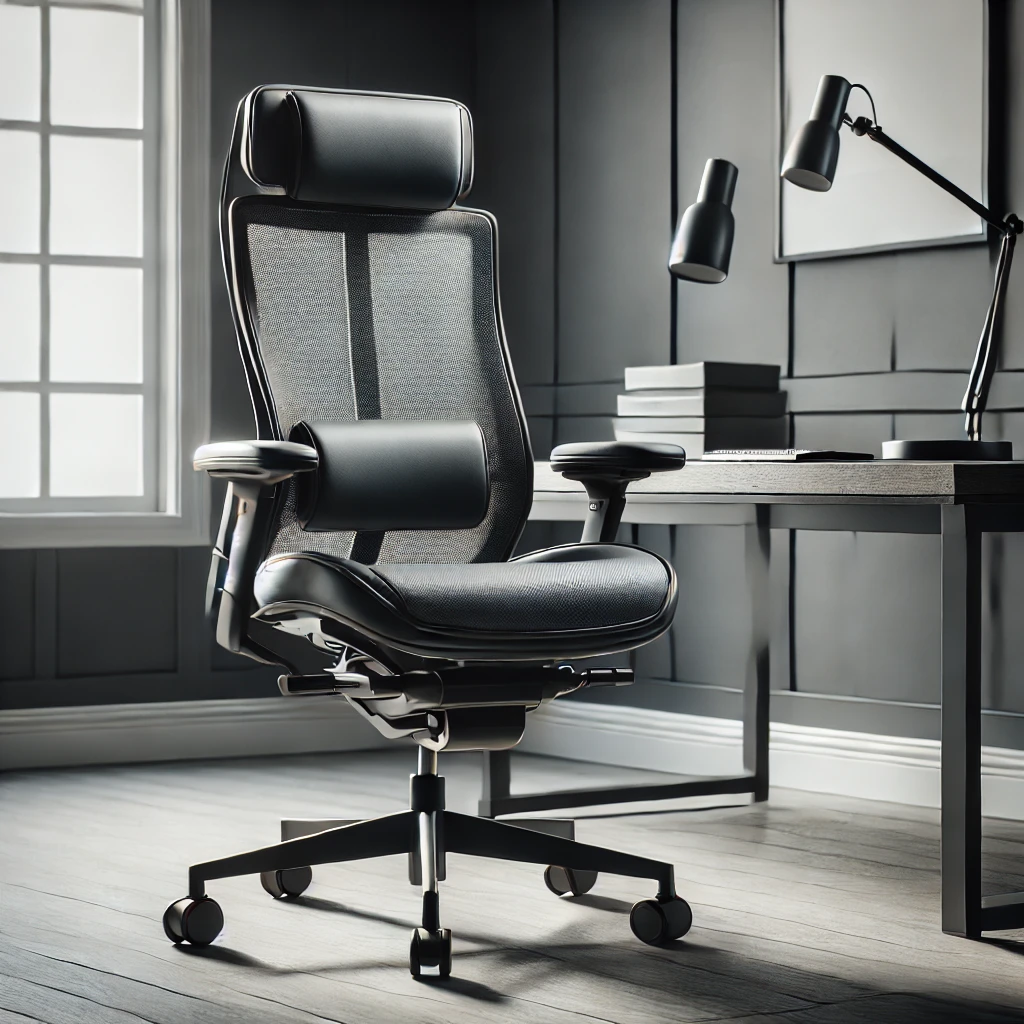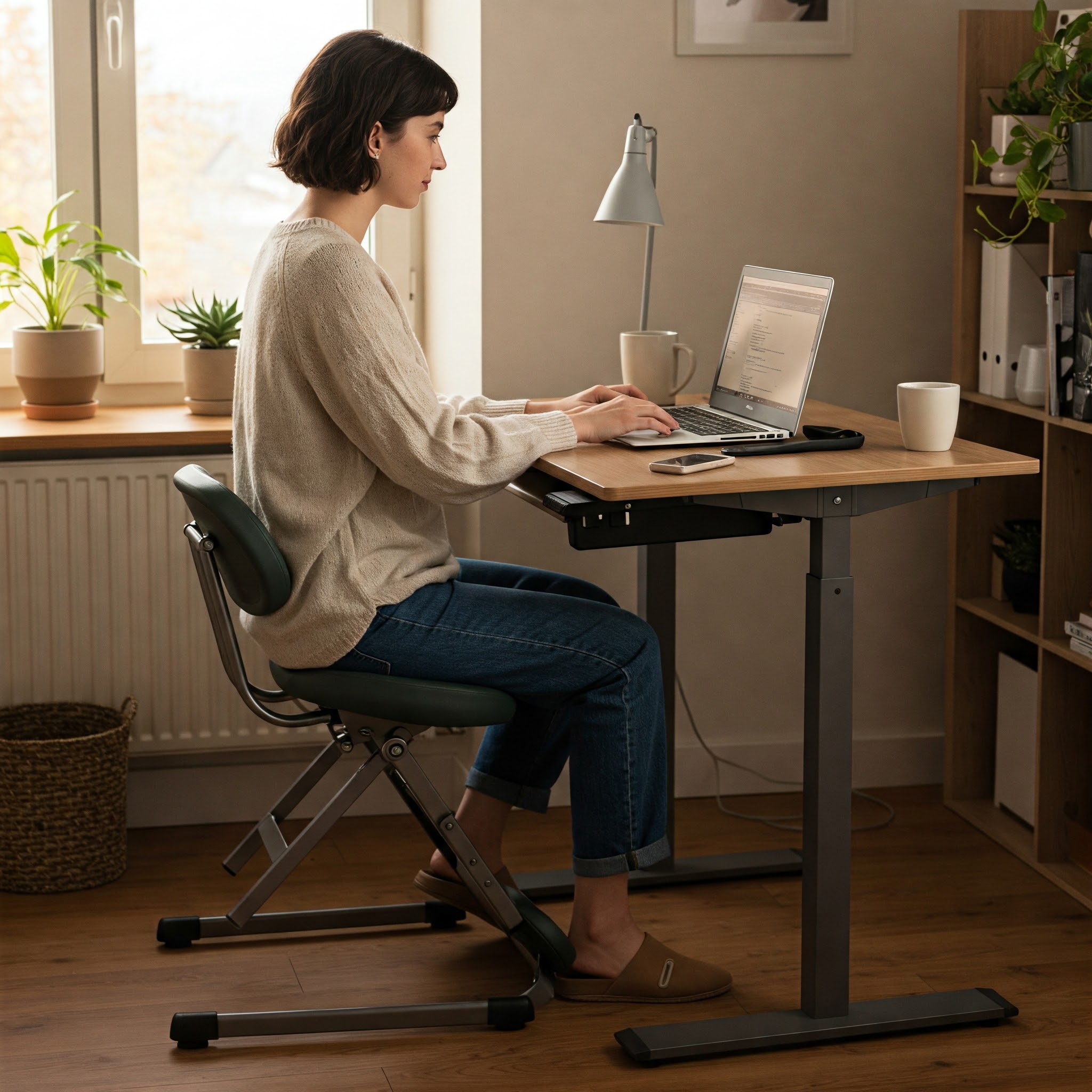Elevating Your Workspace Experience
Are you tired of uncomfortable seating at your counter-height desk? Perhaps you’ve invested in a beautiful standing desk converter or a bar-height workstation, only to find yourself struggling with a chair that just doesn’t quite reach. If so, you’re not alone! Counter high office chairs are the unsung heroes of modern workspaces, bridging the gap between standard office seating and the elevated surfaces that many professionals now prefer.
As someone who has spent countless hours researching and testing various seating options for elevated workspaces, I can confidently say that finding the right counter high office chair can be a game-changer for your productivity and physical wellbeing. Throughout this comprehensive guide, we’ll explore everything you need to know about these specialized chairs, from their unique benefits to the top models currently available on the market.
Let’s face it – the right chair isn’t just about comfort. It’s about supporting your body through long workdays, promoting proper posture, and ultimately, enhancing your overall work performance. Whether you’re setting up a home office, updating your workplace, or designing a creative studio space, the perfect counter high office chair is waiting for you – and I’m here to help you find it.
Understanding Counter High Office Chairs
What Exactly Are Counter High Office Chairs? 🪑
Counter high office chairs, also known as drafting chairs or bar-height office chairs, are specifically designed for use with elevated work surfaces. Unlike standard office chairs that typically sit at a height of 16-21 inches from the floor, counter high chairs can be adjusted to reach heights between 24-36 inches, making them perfect companions for counter-height desks, drafting tables, or standing desk converters.
These specialized chairs maintain all the ergonomic features you’d expect from quality office seating, but with the added benefit of extended height. This means you don’t have to sacrifice comfort or proper posture when working at higher surfaces – a crucial consideration for your long-term health and productivity.
Why Choose Counter High Office Chairs Over Standard Options? ⚡
There are several compelling reasons to invest in a proper counter high office chair rather than attempting to make do with standard seating:
✅ Perfect Height Alignment: Counter high chairs properly align your body with elevated work surfaces, preventing uncomfortable reaching or hunching.
✅ Versatility: Many models offer extensive height adjustment ranges, allowing you to use them with various desk heights.
✅ Ergonomic Support: Quality counter high chairs provide the same lumbar support, adjustable armrests, and comfortable seating as premium standard office chairs.
✅ Improved Circulation: The higher seating position can promote better blood flow, especially when paired with a footrest.
✅ Professional Aesthetics: These chairs are designed to complement modern, height-adjustable workstations for a cohesive office look.
One of the most common mistakes I see is professionals attempting to use a standard office chair with a counter-height desk. This inevitably leads to poor posture, strain on the neck and shoulders, and ultimately, decreased productivity. Investing in the right chair for your specific workspace height is not just a comfort consideration – it’s an essential ergonomic requirement.
Key Features to Look for in Counter High Office Chairs
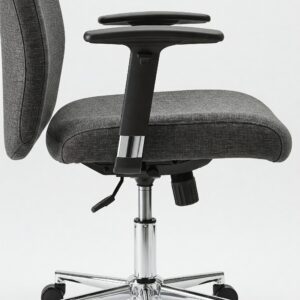
When shopping for counter high office chairs, there are several crucial features that separate the truly supportive models from those that merely look the part. Here’s what you should prioritize:
Height Adjustment Range 🔋
The primary purpose of a counter high chair is to reach elevated work surfaces, so this is perhaps the most critical specification to consider.
✅ Optimal Range: Look for chairs with a maximum height of at least 30-36 inches from the floor to the seat.
✅ Adjustment Mechanism: Pneumatic (gas lift) height adjustment offers the smoothest and most reliable experience.
✅ Lock Functionality: Ensure the chair can be securely locked at your desired height to prevent unexpected sinking.
I’ve found that chairs with a broader height adjustment range offer the most versatility, especially if you work with multiple surfaces or share your chair with others. However, be aware that some ultra-wide range models may sacrifice stability at their highest settings.
Footrest Design and Comfort 👣
Since your feet won’t reach the floor when seated in a counter high chair, a well-designed footrest becomes essential for proper support and comfort.
✅ Circumference: A larger footrest ring provides more positioning options for your feet.
✅ Adjustability: The ability to move the footrest up or down independently of the seat height is invaluable.
✅ Material: Chrome or metal footrests tend to be more durable than plastic alternatives.
✅ Texture: Some footrests feature textured surfaces to prevent foot slippage.
The footrest is often an overlooked component, but after testing dozens of models, I can attest that it makes a tremendous difference in how comfortable you’ll feel during extended work sessions. A poorly designed footrest can lead to leg fatigue and discomfort, regardless of how nice the seat itself might be.
Seat Cushion Quality and Materials 🛋️
Counter high chairs often require longer sitting periods than standing desks, making seat comfort particularly important.
✅ Foam Density: Higher density foam provides better support and lasts longer without compressing.
✅ Width and Depth: Ensure the seat dimensions accommodate your body type comfortably.
✅ Breathable Materials: Mesh or perforated leather helps prevent heat buildup during long sessions.
✅ Waterfall Edge Design: This reduces pressure on the backs of your thighs, improving circulation.
In my experience, chairs with memory foam or high-density cushioning tend to maintain their comfort level much longer than those with basic foam padding. This is definitely an area where investing in quality pays dividends over time.
Back Support and Ergonomics 🦴
Just because you’re sitting higher doesn’t mean you should compromise on proper back support.
✅ Lumbar Support: Look for adjustable lumbar support to maintain the natural curve of your spine.
✅ Backrest Height: A higher backrest provides support for more of your back and sometimes your neck.
✅ Recline Function: The ability to recline slightly can relieve pressure and allow for position changes.
✅ Tension Adjustment: This lets you control how much resistance you feel when leaning back.
After years of testing office chairs, I’ve found that proper lumbar support is non-negotiable for preventing back pain, regardless of the chair’s height. Some counter high chairs skimp on this feature, so be particularly vigilant when assessing back support.
Base Stability and Mobility 🔄
Counter high chairs have a higher center of gravity, making stability especially important.
✅ Base Diameter: Wider bases provide better stability when seated at maximum height.
✅ Material: Aluminum or metal bases generally offer more durability than plastic.
✅ Casters vs. Glides: Consider whether you need mobility (casters) or stability (glides) for your specific workspace.
✅ Weight Capacity: Higher weight ratings usually indicate more robust construction.
I always recommend choosing a chair with a metal base and a weight capacity at least 50 pounds above your actual weight. This ensures long-term stability and reduces wobbling, which can be particularly noticeable at higher seat positions.
Top 10 Counter High Office Chairs in 2025
After extensive research and personal testing, I’ve compiled a list of the most impressive counter high office chairs currently available. Each offers unique advantages depending on your specific needs and budget.
1. DRAGONN Ergonomic Drafting Chair
This chair has become my go-to recommendation for most users seeking their first counter high chair. It strikes an excellent balance between affordability and essential features.
Key Features:
- Height Range: 25.5″ to 33.5″
- 360° adjustable chrome footrest
- Breathable mesh back with lumbar support
- Weight Capacity: 330 lbs
- Flip-up armrests for versatility
Pros:
- Exceptional value for the price point
- Cool mesh back prevents overheating
- Substantial weight capacity for a mid-range chair
Cons:
- Footrest isn’t independently adjustable
- Armrests have limited adjustment options
2. Herman Miller Aeron Drafting Stool
For those with higher budgets who refuse to compromise on ergonomics, the Aeron Drafting Stool represents the gold standard in counter height seating.
Key Features:
- Height Range: 24.5″ to 34″
- PostureFit SL back support system
- 8Z Pellicle suspension material
- Fully adjustable arms
- 12-year warranty
Pros:
- Unmatched ergonomic design
- Exceptional durability and warranty
- Premium materials and construction
Cons:
- Significant investment
- Footrest could be more substantial
3. Flash Furniture Drafting Chair
This budget-friendly option delivers surprising comfort and functionality without breaking the bank.
Key Features:
- Height Range: 23″ to 30.5″
- Ventilated mesh back
- Waterfall seat edge design
- Flip-up armrests
- Chrome foot ring
Pros:
- Very affordable entry point
- Compact design for smaller spaces
- Good breathability
Cons:
- Less padding on the seat
- Not ideal for all-day use
4. Steelcase Leap Drafting Stool
Steelcase brings their renowned ergonomics to the counter height world with this exceptional option.
Key Features:
- Height Range: 24″ to 31.5″
- LiveBack technology that changes with your movements
- 4-way adjustable arms
- Adjustable lumbar support
- Premium fabric options
Pros:
- Adaptive back support
- Excellent build quality
- Multiple customization options
Cons:
- Premium pricing
- Limited color selections
5. HON Volt Drafting Stool
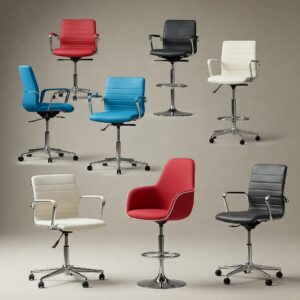
This chair offers remarkable versatility at a mid-range price point that won’t intimidate budget-conscious shoppers.
Key Features:
- Height Range: 23″ to 34″
- Contoured seat cushion
- Synchro-tilt mechanism
- Adjustable footrest
- 5-year warranty
Pros:
- Extended height range
- Simple, intuitive adjustments
- Clean, professional aesthetic
Cons:
- Basic lumbar support
- Limited armrest adjustability
6. Modway Veer Drafting Chair
With its distinctive modern design and solid functionality, the Veer offers an excellent balance of style and substance.
Key Features:
- Height Range: 22.5″ to 30″
- Breathable mesh back
- Padded waterfall seat
- Adjustable footrest ring
- Flip-up arms
Pros:
- Contemporary aesthetics
- Good airflow
- Comfortable seat cushion
Cons:
- Somewhat limited height range
- Plastic components in the base
7. Office Star Deluxe Mesh Drafting Chair
This well-rounded performer offers excellent value with few compromises.
Key Features:
- Height Range: 24.25″ to 33.75″
- One-touch pneumatic height adjustment
- Built-in lumbar support
- Adjustable footrest
- Heavy-duty nylon base
Pros:
- Substantial height range
- Good back support
- Durable construction
Cons:
- Armrests could have more padding
- Assembly can be challenging
8. NOUHAUS Drafting Chair
This newcomer to the market offers impressive features and modern styling at a competitive price point.
Key Features:
- Height Range: 25″ to 33.5″
- ElastoMesh back
- 3D adjustable armrests
- Heavy-duty metal base
- 5-year warranty
Pros:
- Premium-feel adjustments
- Excellent lumbar support
- High-quality casters
Cons:
- Limited color options
- Footrest could be larger
9. Seville Classics Airlift Drafting Chair
This sleek, minimalist option provides excellent functionality with a clean aesthetic that works in any environment.
Key Features:
- Height Range: 24.4″ to 34.4″
- 360° swivel seat
- Adjustable footrest
- Padded armrests
- 2-year warranty
Pros:
- Exceptional height range
- Simple, attractive design
- Easy assembly
Cons:
- Basic back support
- Limited color selection
10. Harwick Evolve Drafting Chair
Rounding out our list is this robust, feature-rich option that caters to those seeking maximum adjustability.
Key Features:
- Height Range: 24″ to 31″
- Multi-function mechanism
- Adjustable lumbar support
- Waterfall seat design
- Lifetime warranty on parts
Pros:
- Highly customizable settings
- Outstanding warranty
- Premium materials
Cons:
- Somewhat complex adjustment process
- Higher price point
Comparison of Top Counter High Office Chairs
| Chair Model | Height Range | Weight Capacity | Key Feature | Price Range |
|---|---|---|---|---|
| DRAGONN Ergonomic Drafting Chair | 25.5″-33.5″ | 330 lbs | Best overall value | $$ |
| Herman Miller Aeron Drafting Stool | 24.5″-34″ | 350 lbs | Premium ergonomics | $$$$ |
| Flash Furniture Drafting Chair | 23″-30.5″ | 250 lbs | Budget-friendly | $ |
| Steelcase Leap Drafting Stool | 24″-31.5″ | 300 lbs | Adaptive back | $$$$ |
| HON Volt Drafting Stool | 23″-34″ | 250 lbs | Extended height | $$ |
| Modway Veer Drafting Chair | 22.5″-30″ | 270 lbs | Modern design | $$ |
| Office Star Deluxe Mesh Drafting Chair | 24.25″-33.75″ | 275 lbs | Value performer | $$ |
| NOUHAUS Drafting Chair | 25″-33.5″ | 300 lbs | 3D armrests | $$$ |
| Seville Classics Airlift Drafting Chair | 24.4″-34.4″ | 270 lbs | Sleek aesthetics | $$ |
| Harwick Evolve Drafting Chair | 24″-31″ | 325 lbs | Lifetime warranty | $$$ |
Ready to transform your workspace comfort? These top-rated counter high office chairs are just a click away! Check the current prices and availability on Amazon to secure the perfect chair for your elevated workspace needs.
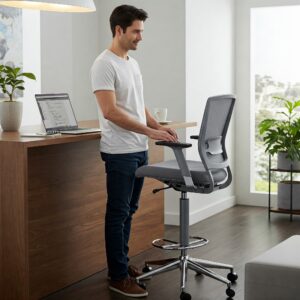
Common Issues with Counter High Office Chairs (And How to Solve Them)
Even the best counter high chairs can present certain challenges. Here are some common issues and practical solutions:
Stability Concerns 🔄
Problem: Some users report wobbling or tipping concerns, especially at maximum height settings.
Solution:
- Ensure your chair has a wide, heavy-duty base (minimum 26″ diameter)
- Consider models with a metal base rather than plastic
- Distribute your weight evenly when seated
- For existing chairs, check that all bolts are properly tightened
I’ve found that chairs with a five-star base design tend to offer better stability than those with fewer points of contact with the floor. Additionally, models with a higher weight capacity generally provide more stability regardless of the user’s actual weight.
Footrest Discomfort 👣
Problem: Many users complain about uncomfortable footrests that cause pressure points or are positioned awkwardly.
Solution:
- Look for independently adjustable footrests
- Consider adding a cushioned footrest cover for metal rings
- Ensure proper sitting height where knees are at approximately 90 degrees
- Try alternative foot positioning throughout the day
In my experience, the ideal footrest should be positioned so that your knees form a 90-degree angle when your feet are resting comfortably. If your current chair doesn’t allow for this, consider an aftermarket footrest or a small stool under your desk.
Limited Armrest Functionality 💪
Problem: Many counter high chairs sacrifice armrest adjustability compared to their standard-height counterparts.
Solution:
- Prioritize models with 3D or 4D adjustable armrests if this feature is important to you
- Consider flip-up armrests for flexibility
- Ensure your armrests don’t prevent you from getting close to your work surface
- Adjust armrests to support elbows at a natural 90-degree angle
I’ve found that armrests become particularly important in counter high chairs, as they help distribute upper body weight and reduce shoulder strain during long work sessions.
Difficulty with Desk Clearance 📏
Problem: Some users struggle to fit their counter high chairs properly under their desk or workstation.
Solution:
- Measure carefully before purchasing (both maximum chair height and under-desk clearance)
- Consider models with flip-up armrests if space is tight
- Ensure your desk height is compatible with your chair’s maximum height plus adequate clearance
- Look for slimmer seat designs if working in cramped spaces
The key measurement to consider is the distance from the floor to the underside of your work surface, minus about 8-10 inches for comfortable thigh clearance.
Ergonomic Tips for Using Counter High Office Chairs
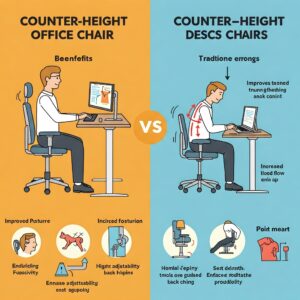
Using a counter high chair properly is just as important as choosing the right model. Here are my top recommendations for optimizing your setup:
Proper Height Adjustment 📊
The fundamental rule of ergonomic seating applies regardless of chair height: your knees should form approximately a 90-degree angle when seated. For counter high chairs:
✅ Adjust your chair height so your work surface falls at elbow level when your arms are bent at 90 degrees
✅ Position the footrest so your knees are also at roughly 90 degrees
✅ Ensure your eyes naturally align with the top third of your monitor
✅ Make small adjustments throughout the day as needed
Strategic Footrest Usage 🦶
Your footrest should be your ally in maintaining comfort throughout the day:
✅ Alternate foot positions periodically to prevent pressure points
✅ Consider using an anti-fatigue mat beneath your chair if you frequently transition between sitting and standing
✅ Ensure the footrest is stable and doesn’t rotate unintentionally
✅ Allow enough room on the footrest to change positions frequently
Posture Maintenance Techniques 🧘♂️
Elevated seating can sometimes lead to posture challenges:
✅ Set a timer to check your posture every 30 minutes
✅ Utilize the chair’s lumbar support to maintain the natural curve in your lower back
✅ Keep shoulders relaxed and down, not hunched or elevated
✅ Position your head directly above your shoulders, not jutting forward
Movement Integration Strategies 🚴♂️
No chair, regardless of quality, is designed for static all-day sitting:
✅ Incorporate micro-movements every 15-20 minutes
✅ Stand up completely at least once per hour
✅ Consider alternating between counter height sitting and standing throughout the day
✅ Perform simple desk stretches to combat stiffness
Adapting Your Workspace for a Counter High Chair
Adding a counter high chair to your workspace might require some additional adjustments for optimal ergonomics and functionality:
Desk Height Compatibility 📐
Before purchasing a counter high chair, ensure your existing desk can accommodate it:
- Standard countertop height is typically 36 inches, requiring a chair with a maximum seat height of at least 28-30 inches
- Bar height surfaces (around 42 inches) require chairs with even taller maximum heights
- Adjustable height desks offer the most flexibility but verify their maximum height
I recommend measuring the distance from the floor to the underside of your work surface, then comparing this to the maximum seat height of your prospective chair plus about 8-10 inches for thigh clearance.
Monitor Positioning 🖥️
When sitting higher, monitor height often needs adjustment:
- Position your monitor(s) so the top of the screen is at or slightly below eye level
- Consider a monitor arm for easier adjustments between sitting and standing
- Maintain a viewing distance of approximately arm’s length
- Adjust screen angle to minimize glare
Keyboard and Mouse Placement ⌨️
Proper input device positioning becomes even more critical at counter height:
- Your keyboard should be positioned so your elbows remain at approximately 90 degrees
- Consider a keyboard tray if your counter surface is too high for comfortable typing
- Maintain a neutral wrist position, avoiding extreme angles
- Keep frequently used items within easy reach to avoid stretching
Floor Surface Considerations 🧹
The floor beneath your counter high chair deserves attention too:
- Hard floors may benefit from a chair mat to protect surfaces and improve mobility
- Carpet requires either a chair mat or specialized casters designed for carpeted surfaces
- Consider an anti-fatigue mat if you frequently transition between sitting and standing
- Ensure enough clearance for your chair to move as needed without obstacles
FAQs About Counter High Office Chairs
Are counter high office chairs the same as drafting chairs? 🔍
While the terms are often used interchangeably, there are subtle differences. Drafting chairs were originally designed for architects and designers working at angled drafting tables, typically featuring a minimalist design with a footrest ring and no armrests. Modern counter high office chairs have evolved from this concept but generally include more ergonomic features and adjustability options suited for computer work rather than drafting. However, in today’s market, you’ll find many chairs labeled as both “drafting” and “counter high” that share the same essential features.
How tall should a counter high office chair be? 📏
The ideal height depends on your work surface. For standard counter-height desks (typically 36 inches tall), look for chairs with a maximum seat height of at least 28-30 inches. This allows your elbows to rest comfortably at desk level. For bar-height surfaces (approximately 42 inches), you’ll need chairs that reach 33-36 inches at their maximum setting. Always ensure there’s a 6-8 inch difference between your seat height and desk height for proper ergonomics.
Do counter high chairs work with standard desks? 🤔
Most counter high chairs can be lowered to function with standard desks, but they may not offer the same comfort or ergonomic benefits in this position. The footrest ring, which is essential at higher positions, may become an obstacle at lower heights. If you frequently switch between standard and counter-height surfaces, look for models with exceptionally wide height adjustment ranges and removable or height-adjustable footrests.
How can I make my existing office chair taller for a counter height desk? 🛠️
While not ideal, there are several options to elevate an existing chair:
- Chair cylinder extensions can add 2-4 inches to your chair’s height
- Drafting chair kits can convert some standard office chairs to counter height
- Seat cushions can provide a minor height boost of 1-2 inches
However, these solutions typically compromise stability and ergonomics. For regular use at counter height, investing in a proper counter high chair is strongly recommended.
Are counter high chairs good for your back? 🦴
When properly adjusted and used, quality counter high chairs can be just as supportive for your back as standard ergonomic chairs. Look for models with adjustable lumbar support, proper seat depth, and a supportive backrest. The key difference is the need for proper footrest use, as dangling feet can lead to increased pressure on the spine. When set up correctly, a good counter high chair maintains proper spinal alignment and can help prevent back pain.
Making an Informed Purchase Decision
With so many options available, how do you make the final decision on which counter high office chair is right for you? Here’s my proven approach:
Assess Your Specific Needs 📝
Before comparing models, clarify your priorities:
- Usage Duration: Will you be sitting for 8+ hours daily, or just occasionally?
- Space Constraints: Do you need a compact chair, or is space not an issue?
- Mobility Requirements: Will you need to move frequently between workstations?
- Aesthetic Preferences: Does the chair need to match existing office décor?
- Special Physical Considerations: Do you have existing back issues or other physical needs?
Understanding your specific requirements will help narrow down the features that matter most to you.
Budget Considerations 💰
Counter high chairs range dramatically in price, from under $100 to well over $1,000. While budget is inevitably a factor, consider these principles:
- The longer you’ll be sitting daily, the more you should invest in quality
- Focus your budget on the features most important to your specific needs
- Remember that a quality chair is an investment in both productivity and health
- Consider warranty length as part of the total value equation
In my experience, the sweet spot for most users is between $200-$500, where you’ll find chairs with good ergonomics and durability without premium pricing.
Try Before You Buy 👆
If possible, test chairs in person before purchasing:
- Visit office furniture showrooms to try different styles
- If ordering online, check return policies carefully
- Consider borrowing or trying a colleague’s chair if they have a model you’re considering
- Sit in the chair for at least 15-20 minutes to truly assess comfort
If in-person testing isn’t possible, thoroughly read user reviews from people with similar body types and usage patterns to yours.
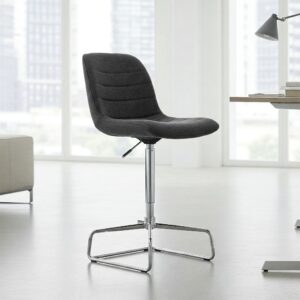
Conclusion: Elevating Your Workspace Experience
Finding the perfect counter high office chair is more than just a furniture decision – it’s an investment in your daily comfort, productivity, and long-term health. Throughout this guide, we’ve explored the essential features, top models, and practical considerations to help you make an informed choice that suits your unique needs.
Remember that the ideal chair strikes a balance between ergonomic support, adjustability, and quality construction. While premium models certainly offer advantages in terms of durability and features, there are excellent options available at every price point. The key is identifying which features matter most for your specific workspace and physical requirements.
As remote and flexible work arrangements continue to evolve, creating an ergonomic workspace at home is more important than ever. A quality counter high office chair is a foundational element of that setup, especially if you’ve invested in a counter-height desk or standing desk converter.
Ready to transform your workspace comfort? The perfect counter high office chair for your needs is just a click away on Amazon. Check out our top recommendations today and experience the difference proper seating can make in your daily work life!
More FQAs:
❓ What is a counter high office chair?
✅ A counter high office chair is designed for use with elevated desks or countertops, offering extended seat height and foot support for ergonomic comfort…
❓ Are counter high office chairs adjustable?
✅ Yes, most counter high office chairs feature pneumatic height adjustment, allowing users to align comfortably with taller work surfaces…
❓ Do counter high office chairs have footrests?
✅ Many counter high office chairs include built-in foot rings or footrests to reduce leg fatigue and promote better posture while sitting higher…
❓ What’s the ideal seat height for a counter high office chair?
✅ The ideal seat height for a counter high office chair typically ranges from 24 to 27 inches, depending on the height of the counter or desk…
❓ Can counter high office chairs be used at standing desks?
✅ Yes, counter high office chairs are often used with standing desks, providing a sit-stand option for users who alternate positions during the day…
Recommended for You:
- Couch Office Chair: 7 Incredible Ways to Transform Your Workspace Today
- 10 Best Alternative Desk Chairs to Supercharge Your Comfort in 2025
- Unique Office Chairs: 7 Extraordinary Options for Your Workspace in 2025
Disclaimer: This article contains affiliate links. If you purchase products through these links, we may earn a small commission at no additional cost to you.



